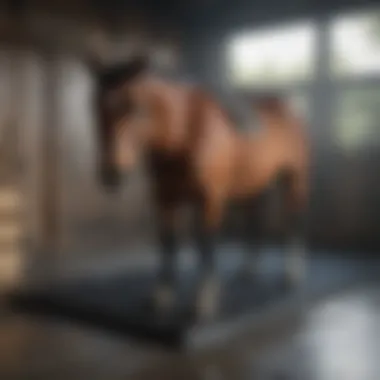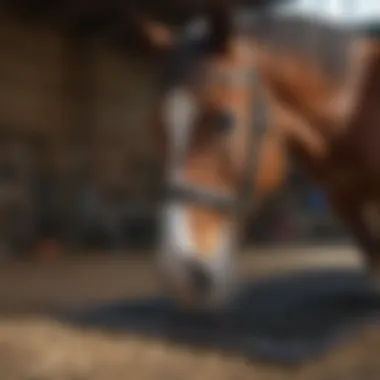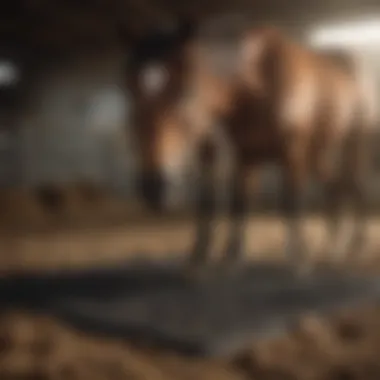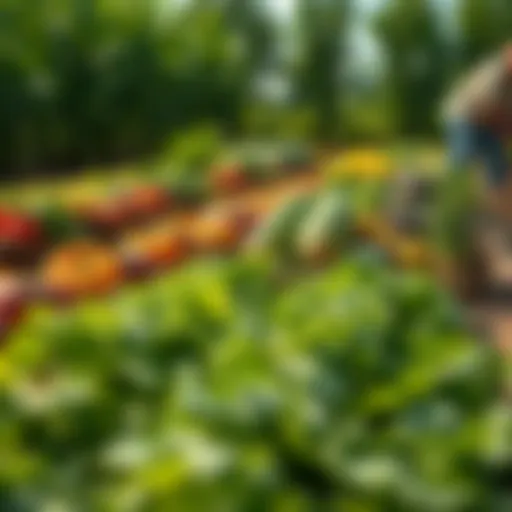Exploring TSC Rubber Horse Mats: Benefits and Applications


Intro
TSC rubber horse mats serve a vital role in equine care and agricultural practices. As horse management becomes increasingly important, so does the demand for durable and safe flooring solutions. Horses require a comfortable and non-slip surface system that not only enhances their well-being but also aids in managing their environment effectively. TSC rubber mats emerge as a solution that offers both resilience and functionality.
The selection of appropriate flooring for equine facilities influences not only the health of the horses but also the overall efficiency of agricultural operations. These mats cater to the specific needs of horse owners and farmers alike, providing insights and advantages that improve daily practices.
With a focus on TSC rubber horse mats, this article unfolds the context, benefits, and applications that highlight their significance in sustainable equine care, which is crucial in today's farming landscape.
Understanding TSC Rubber Horse Mats
Understanding TSC rubber horse mats is crucial for those involved in horse management, as these mats offer various advantages tailored to the specialized needs of equine care. The significance of these mats lies not only in their utility but also in their contribution to a safer, more comfortable environment for horses. Owners and caretakers must recognize the elements that define these mats and how they integrate into daily practices.
TSC rubber horse mats serve as versatile flooring solutions. They are made from high-quality rubber materials that aim to withstand wear and tear associated with equine activities. This durability is essential for reducing maintenance efforts in stables and trailers, which can lead to cost savings over time. Furthermore, understanding the composition of these mats helps in selecting the right product that fits specific needs in various equine environments.
Definition and Composition
TSC rubber horse mats are engineered products designed specifically for equine settings. These mats consist notably of natural rubber combined with synthetic polymers. The composition also includes various additives to enhance properties such as strength, flexibility, and resistance to harsh weather conditions. The resulting product is a mat that can absorb impact and provide support to horses' joints.
The standard dimensions of these mats are typically four feet by six feet, which allows for easy installation and mobility. They often feature a textured surface to improve traction, ensuring that horses have a secure footing in both stable and outdoor settings. These characteristics contribute to the overall safety and comfort of the horses, which is vital for their well-being.
Manufacturing Processes
The manufacturing of TSC rubber horse mats involves several steps, ensuring that they meet quality standards required for equine use. The process begins with the collection of raw materials, primarily rubber, which is sourced from various suppliers. The rubber undergoes cleaning and processing to remove impurities and enhance its properties.
Next, the processed rubber is mixed with specific additives in precise proportions. This mixture is crucial for developing the desired hardness and flexibility of the mats. After mixing, the compound is shaped into mat forms and subjected to a curing process. During curing, heat and pressure are applied to ensure that the mats achieve their final properties, such as durability and non-slip features.
Finally, the mats are inspected for quality assurance. Each mat undergoes rigorous testing to confirm that it meets safety standards for equine use. The result of this comprehensive manufacturing process is a high-quality product that offers significant benefits for horse owners and caretakers.
Key Benefits of TSC Rubber Horse Mats
Understanding the key benefits of TSC rubber horse mats is essential for horse owners and agricultural enthusiasts. These mats provide numerous advantages in horse management, which ultimately leads to improved animal welfare and productivity. The features discussed here accentuate the significance of TSC rubber horse mats in various settings, covering durability, safety, comfort, and maintenance aspects.
Durability and Longevity
TSC rubber horse mats are designed to withstand harsh conditions. They resist wear and tear that comes from regular use, making them a long-term investment. These mats can last for many years, even in high-traffic areas. The durability factor ensures that horse owners do not have to frequently replace the mats, leading to savings in both time and money. They also maintain their structural integrity despite exposure to moisture and manure, crucial for stable environments. This longevity supports a consistent and safe environment for horses, thereby enhancing their overall well-being.
Safety Features
Safety is paramount when managing horses. TSC rubber horse mats feature multiple safety features that make them a preferred choice for many horse owners.
Non-Slip Surface
The non-slip surface of TSC rubber horse mats provides excellent traction. This feature is vital to prevent slips and falls that may lead to injuries. The textured surface grips the hooves effectively, providing stability even in wet conditions. This characteristic positions the non-slip aspect as a beneficial attribute for horse mats, ensuring that equine activities can occur without fear of accidents. It’s a significant advantage, particularly in busy stable environments or during transportation.
Shock Absorption
The shock absorption capability of these mats is another key aspect. When horses move or play, the impact can be considerable. TSC rubber horse mats mitigate this impact with their dense material, reducing the risk of injury from falls or high-impact activities. This feature is crucial, especially for young horses or those in training. The comfort provided by shock absorption also promotes better recovery from workouts or injuries, which is essential for maintaining overall health.
Comfort for Horses
Comfort plays an important role in horse management. TSC rubber horse mats provide a cushioned surface that promotes comfort. Horses spend a lot of time standing, and a soft surface alleviates pressure on their joints. A comfortable mat can prevent fatigue and reduce the risk of developing sore hooves or leg problems. Providing a cozy space enhances their overall happiness and well-being, which directly correlates with their performance in various activities.
Ease of Maintenance
One of the significant advantages of TSC rubber horse mats is their ease of maintenance. Unlike traditional bedding materials, these mats are easier to clean and maintain. Manure and dirt can be easily swept or hosed off, ensuring a hygienic environment for the horses. This ease of maintenance not only saves time but also helps in maintaining the health of the horses. A cleaner environment reduces the risk of diseases and promotes better living conditions.
Applications in Horse Management
TSC rubber horse mats offer several unique advantages that make them highly relevant in equine management. Their utility is supported by principles focusing on safety, comfort, and practicality. The well-being of horses is a central consideration in this discussion. With stables, trailers, and outdoor spaces all contributing to a horse's environment, the application of these mats becomes integral to quality management.


Stable Flooring Solutions
Creating a safe and comfortable stable begins with selecting the right flooring. TSC rubber horse mats provide a significant upgrade over traditional surfaces. They minimize the risk of slips and falls due to their non-slip surface features. This is crucial in maintaining horse safety, especially in high-traffic areas.
Moreover, these mats are designed to withstand harsh conditions. They resist wear from both equine activity and cleaning practices. For barn staff, maintenance of flooring plays an essential role in ensuring health standards. Regular cleaning is simplified with rubber mats, reducing the time and effort needed for upkeep.
Trailers and Transport
Transporting horses is delicate work and requires careful consideration of safety and comfort during transit. TSC rubber horse mats stand out in this context. They cushion the floors of trailers, absorbing shocks during travel. This helps horses stay calm even on bumpy roads.
Additionally, a rubber matting surface dampens noise, which can comfort anxious horses. This becomes important for long journeys. Also, these mats are lightweight and modular, allowing for easy removal and cleaning. This means that equestrian owners can maintain hygiene standards without difficulties.
Outdoor Use Cases
The applications of TSC rubber horse mats extend beyond indoor environments. They can be used effectively in outdoor settings like riding arenas or paddocks. When utilized outdoors, these mats help manage muddy areas, preventing erosion and creating a clean area for horses.
Their robust design also facilitates drainage. Rainwater does not accumulate but flows through the mat's structure, reducing the risk of moisture buildup. This feature is beneficial in maintaining healthy living conditions for the horses. Furthermore, outdoor mats can withstand various weather conditions, ensuring longevity and performance over time.
Sustainability Considerations
Sustainability is an increasingly important topic in today's world. In the context of TSC rubber horse mats, the focus on sustainability reflects a broader commitment to environmentally conscious practices within agriculture. The examination of sustainability considerations allows us to understand how these mats not only contribute to improved equine care but also to reduced environmental impact. Here, we will analyze aspects like recycling and eco-friendliness as well as the reduction of waste associated with rubber horse mats.
Recycling and Eco-Friendliness
TSC rubber horse mats are designed with eco-friendliness in mind. They can be recycled, which minimizes the amount of waste that ends up in landfills. The materials used in these mats often come from post-consumer products, thus repurposing resources that would otherwise contribute to environmental pollution. This recycling aspect is significant for horse owners and farmers who are increasingly aware of their ecological footprint.
- Benefits of recycling TSC rubber mats include:
- Conservation of raw materials: By recycling, it prevents the depletion of natural resources.
- Lower carbon emissions: Recycling processes typically involve fewer emissions than producing new materials.
- Downcycling: Even if the mats cannot be reused in their original form, they can often be transformed into other useful products, extending their lifecycle.
Raising awareness about the recyclable nature of TSC rubber mats encourages more producers and consumers to adopt sustainable practices. This benefits both the environment and the agricultural community.
Reduction of Waste
The reduction of waste is a critical component of any sustainable practice. TSC rubber horse mats contribute to this goal in several ways. First, their durability means they have a longer lifespan compared to traditional bedding materials like straw or shavings. This longevity not only cuts costs but also reduces the frequency of replacement, directly correlating with a decrease in waste generation.
Moreover, when TSC rubber mats reach the end of their functional life, they are suitable for recycling programs that specifically cater to rubber products. This avoids disposal in landfills, which is a common fate for many agricultural materials.
According to industry insights, the longevity of rubber mats can lead to:
- Less frequent replacements: Farmers and horse owners will find themselves changing mats less often, leading to decreased demands on supply chains.
- Smaller disposal volumes: With fewer mats being thrown away, the overall material waste in the equine industry is significantly lowered.
"Implementing sustainable practices in equestrian management not only helps the planet but also benefits the economic aspects of horse care."
By choosing TSC rubber horse mats, equestrian operations can contribute to a more sustainable future, showcasing a commitment to environmental responsibility while ensuring the utmost comfort and safety for horses.
Installation Guide for TSC Rubber Horse Mats
The installation of TSC rubber horse mats deserves careful attention. A proper installation ensures the longevity and maximum functionality of the mats, making them an essential part of effective horse management. Attention to detail in the installation process can prevent future complications, such as uneven surfaces and safety hazards. Furthermore, a well-installed mat can contribute significantly to the comfort and well-being of the horses. In short, this section provides crucial guidelines for maximizing the benefits of these mats.
Preparation of the Area
Before laying down TSC rubber horse mats, proper area preparation is key. Start by selecting the installation site. The area should be level and free from debris. Remove any old flooring materials, such as wood or dirt. It's also wise to inspect for any unevenness in the ground; leveling it as much as possible can prevent issues later on.
After cleaning and leveling the space, make sure to measure it. Accurate measurements help with planning the layout of the mats, ensuring that you avoid unnecessary cuts or gaps.
- Clear any obstacles: Remove any items that can obstruct the installation.
- Assess humidity and weather conditions: Installing mats during dry weather is preferred.
- Check for drainage systems: Ensure that water does not pool under the mats.
Step-by-Step Installation Process
With preparation complete, the installation can begin. Follow these steps to ensure a smooth process:


- Lay the First Mat: Start by positioning the first mat in the corner of the area. Ensure that it is aligned properly with the walls.
- Fit Remaining Mats: Place the next mat adjacent to the first one. Push them together tightly to avoid gaps. Make sure there is no overlapping; proper alignment is crucial.
- Cut Mats if Necessary: If a mat does not fit, use a utility knife to cut it to size. Always wear safety gloves when using cutting tools.
- Secure the Mats (if needed): Depending on the situation, you might need to secure mats with adhesives or fasteners. This step is especially important in high-traffic areas.
- Final Inspection: Once all mats are laid, conduct a final check. Ensure all seams are tight and there are no loose areas.
Proper installation not only enhances safety but also prolongs the lifespan of the mats, making future investments more worthwhile.
By adhering to this installation guide, you can optimize the benefits of TSC rubber horse mats in your equine environment, leading to improved horse management.
Maintenance of Rubber Mats
Maintaining TSC rubber horse mats is a crucial aspect that affects their performance and longevity. Regular maintenance not only ensures the mats remain functional but also contributes to the overall health and safety of the horses. Given their significant investment, understanding the right maintenance techniques is vital for horse owners and facilities that rely on these mats for daily operations.
A well-maintained rubber mat can prevent wear and tear, reduce the risk of injury to horses, and improve the aesthetic appeal of the stable environment. This section guides readers through essential maintenance practices and offers insights into assessing the condition of the mats.
Regular Cleaning Practices
The cleanliness of rubber mats is paramount. Regular cleaning helps to remove dirt, manure, and other debris that can accumulate over time. Such buildup not only diminishes the appearance of the mats but can also lead to bacteria growth, posing health risks to horses.
Some effective cleaning practices include:
- Daily sweeping or hosing down: Use a broom or hose to clear away loose debris each day.
- Occasional deep cleaning: Invest in a pressure washer to eliminate stubborn stains and compacted dirt that regular cleaning might miss. This should be done every few months depending on the foot traffic.
- Use of non-toxic cleaning agents: Opt for biodegradable soaps or cleaners that are safe for horses. Avoid harsh chemicals that can degrade the rubber material over time.
Implementing these cleaning practices will maintain the hygiene and overall condition of the mats, enhancing their lifespan.
Inspecting for Wear and Tear
Regular inspections are essential to identify any signs of damage or degradation. Horses can exert considerable pressure on mats, and crucial components such as seams may become compromised. Checking for wear and tear ensures that mats continue to support horses effectively without posing risks.
Here are some key points to consider during inspections:
- Look for cracks or cuts: Examine mats for visible cracks or cuts which may worsen with time.
- Check seams and edges: Inspect the perimeter of the mats where they may experience more wear.
- Monitor thickness: The thickness of the mats can degrade, especially in high-traffic areas. Thinner areas may need to be replaced sooner.
- Assess odor and moisture: Persistent odors or moisture could indicate trapped waste underneath, requiring immediate attention to prevent mold growth.
Quote: Regular inspection not only prevents major issues but also extends the life of your mats, making it easier on your wallet in the long run.
By being proactive in both cleaning and inspecting TSC rubber horse mats, owners can ensure a safe, hygienic environment for their horses. This approach benefits not only the mats and horses but also enhances the overall functionality of the equine care facilities.
Comparative Analysis of Horse Mats
Understanding the comparative dynamics between horse mats is essential for informed decisions in horse management. Different materials serve varying needs, and this section evaluates their merits in practical applications. Knowing the pros and cons can help horse owners safeguard their investments while ensuring the health and comfort of their animals.
Rubber vs. Other Materials
Rubber mats, such as those produced by TSC, have certain advantages when compared to other materials like straw, concrete, or wood. First and foremost, rubber offers superior shock absorption, making it a safer option for horses prone to injuries.
- Durability: Rubber mats are generally more durable than straw or shavings, which can break down and require replacement. Although wood might seem sturdy, it can warp or splinter over time.
- Maintenance: Rubber requires minimal maintenance compared to traditional bedding. Cleaning involves simply sweeping or hosing down the surface, while straw and shavings may need daily management to maintain hygiene and comfort.
- Water Resistance: Unlike wood, which can absorb moisture, rubber mats create a non-porous surface where urine and water run off, reducing the likelihood of mold and odor accumulation.
However, alternatives like EVA foam are lightweight and can offer comfortable cushioning, but they may not provide the same level of durability and longevity as rubber.
Cost-Benefit Analysis
When assessing TSC rubber horse mats through a cost-benefit lens, the initial investment may seem high compared to materials like straw or wood shavings. Yet, it often yields long-term savings because of its durability and low upkeep requirements.
- Long-term Savings: Given their longevity, rubber mats can last for years, making the price per year of use significantly lower than buying bedding often.
- Health Benefits: Investing in high-quality mats can reduce the risk of injuries. This not only saves potential veterinary costs but also promotes better overall health for the horses.
- Comfort and Performance: Comfortable horses are more likely to perform well, whether for competitive riding or general exercise. This aspect can translate to better outcomes financially for competitive horse owners.
User Experiences and Reviews
User experiences and reviews play a crucial role in understanding the real-world applicability of TSC rubber horse mats. When potential buyers consider the investment in these mats, they seek authentic feedback from current users. This topic provides valuable insights into how the mats perform over time, their effectiveness in various conditions, and the overall satisfaction among horse owners and caretakers.
Understanding user experiences allows new customers to gauge the reliability and practicality of TSC rubber horse mats. Genuine testimonials highlight not only the strengths of the product, such as durability and safety features, but also any challenges or shortcomings observed. This balanced perspective significantly aids in informed decision-making.
Insights from Horse Owners


Horse owners consistently share positive feedback regarding TSC rubber horse mats. Many highlight the mats’ resilience, particularly in areas exposed to water, mud, and heavy use. The non-slip surface design is often lauded for providing a safe environment for both horses and handlers. Numerous owners report reduced incidences of slips and falls, which can lead to serious injuries.
Additionally, the comfort factor is frequently mentioned. Horses display a preference for resting and moving on softer surfaces, which these mats provide. Specifically, the shock absorption properties help to alleviate impact on horse joints, promoting better overall health.
Here are some common insights shared by horse owners:
- Durability: Many reports indicate that the mats maintain their integrity even under extreme conditions.
- Ease of installation: Owners appreciate simplified installation guidelines, making setup straightforward.
- Maintenance ease: The majority found cleaning and upkeep to be manageable, ensuring mats remain in good condition over time.
Veterinary Perspectives
Veterinary professionals often emphasize the importance of appropriate flooring for equine health. The use of TSC rubber horse mats is generally recommended due to their positive influence on horse well-being. Veterinarians note that the right flooring can mitigate risks associated with joint issues and hoof problems.
In reviews, vets have observed that horses interacting with TSC mats demonstrate less stress and discomfort. As these mats cushion impacts, they may reduce the likelihood of injuries during movement. Moreover, veterinarians also appreciate how the non-porous surface aids in maintaining hygiene, as it can be cleaned easily, thereby reducing the risk of bacterial infections.
Some recommendations from veterinary perspectives include:
- Assessing the stability of the mats regularly to ensure they remain secure and safe for use.
- Encouraging horse owners to observe their animals’ behavior on the mats, looking for signs of discomfort or hesitation.
- Stressing the significance of a holistic approach where flooring is just one aspect of horse care.
Overall, the feedback from both horse owners and veterinarians underlines the significance of TSC rubber horse mats in promoting safe and healthy environments for horses.
Future Trends in Horse Mats
In the ever-evolving landscape of equine management, understanding future trends in horse mats is crucial. TSC rubber horse mats are not just a basic necessity but an evolving aspect of horse care and management strategies. Focusing on the latest developments and shifts in marketplace dynamics provides valuable insights into how the industry can adapt to the changing needs of horse owners and care facilities.
Innovations in Material Science
The advancement of material science plays a significant role in the future of horse mats. New formulations of rubber, for example, are being developed to enhance durability and reduce environmental impact. Scientific breakthroughs have led to the creation of lighter materials without sacrificing strength and resilience.
These innovative materials often combine recycled rubber with new compounds to improve flexibility and reduce cracking or wear over time. Furthermore, the addition of antimicrobial agents helps in managing hygiene while minimizing odor from waste. It is expected that these innovations will continue to push boundaries in performance and usability.
Key Focus Areas:
- Enhanced flexibility and durability
- Use of recycled materials
- Improved hygiene features
- Environmentally friendly compounds
These aspects are critical as consumers become more aware of their buying choices. The demand for sustainable products is rising, affecting how manufacturers approach production.
Emerging Market Trends
As we analyze emerging market trends, it’s evident that there is a growing shift towards more multipurpose equine products. TSC rubber horse mats are increasingly seen not only as flooring solutions but also as part of a broader holistic approach to horse welfare.
The market is experiencing an inclination towards modular and customizable systems that allow for tailored solutions based on specific needs. For instance, horse mats that are adaptable for various settings—be it for stables, outdoor use, or transport—are gaining favor.
Additionally, e-commerce platforms are reshaping how consumers access and purchase horse mats. An increase in online sales and opportunities for direct-to-consumer models can also expedite market growth.
Market Insights:
- Rise in demand for customizable products
- Growth of online purchasing platforms
- Increased focus on horse welfare and comfort
- Shift towards sustainable manufacturing practices
These trends suggest an exciting time ahead for TSC rubber horse mats, indicating potential growth trajectories fueled by innovation and a consumer base that increasingly values quality and sustainability.
Epilogue and Final Thoughts
The exploration of TSC rubber horse mats highlights the key aspects that impact both equine care and agricultural practices. The combination of durability, safety features, and ease of maintenance makes these mats a valuable asset in various contexts. Understanding their benefits serves as a guide for stakeholders in horse management, including farmers, stable owners, and veterinarians.
Rubber horse mats are designed not only to provide comfort and safety for horses but also to promote a more sustainable approach to equine care. Their impact extends beyond immediate use; it raises important considerations regarding waste reduction and material efficiency.
Overall, the adoption of TSC rubber horse mats signifies a proactive step towards enhanced animal welfare and environmental responsibility.
Summary of Key Insights
- Durability: TSC rubber horse mats are built to last, resisting wear and tear from daily use. Their long lifespan projects significant cost savings over time.
- Safety Features: The non-slip surface and shock-absorbing properties contribute to the safety of both horses and handlers, reducing the likelihood of accidents.
- Comfort: With a cushioned surface, these mats provide comfort for horses, promoting better health and well-being by minimizing strain during movement and rest.
- Easy Maintenance: Cleaning these mats is a straightforward task, allowing for quick upkeep and ensuring a hygienic environment for horses.
- Sustainability: The eco-friendly credentials of TSC rubber mats align with contemporary agricultural practices that prioritize environmental health.
Implications for Future Practices
The increasing awareness of sustainable practices calls for a shift in how horse management operates. The widespread adoption of TSC rubber horse mats could lead to significant changes in stabilizing floor designs and transport solutions.
- Adoption of these mats supports a trend of prioritizing animal welfare and longevity of resources, encouraging farmers to consider environmental impacts in their decision-making.
- Future innovations could focus on enhancing the properties of rubber to improve resilience, even more, or explore biodegradable options, aligning with the growing demand for sustainable materials.
- The integration of these mats into various equestrian disciplines can redefine standards, encouraging a holistic approach to horse care that is both progressive and respectful of animal needs.







